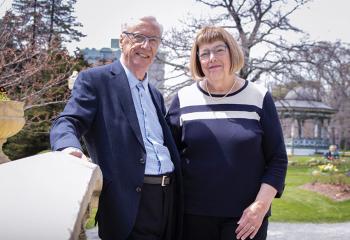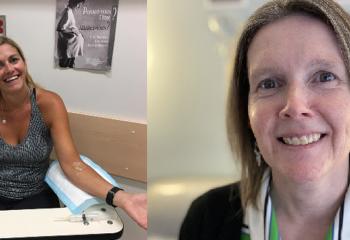
Wayne Hatcher and his wife Juanita were extra grateful to be together during Christmas 2023. While they’d recently found out Wayne’s cancer had returned through a new test at the QEII, they were happy the cancer had been found so quickly. Wayne had surgery on January 3, 2024 to remove the tumours. CONTRIBUTED
In January 2024, Wayne Hatcher was recovering and resting comfortably in his Hatchet Lake home, after having two tumours removed from his lung on January 3.
“I’m just grateful that I was able to fix a lovely breakfast for my wife this morning,” Wayne says.
“Then I was out feeding the ducks on my property.”
Wayne’s tumours were detected by a new Gallium-68-PSMA (prostate-specific membrane antigen) scan. He was among the earliest cohort of patients in Atlantic Canada to benefit from this scanning capability at the QEII Health Sciences Centre in Halifax.
“Without that scan this cancer would have spread to other parts of my body,” he says. “This has given me a new lease on life.”
Wayne had been diagnosed with prostate cancer — the most common cancer in men — in June 2018 and following surgery later that year, he had made a full recovery. The followup included testing every three months to measure the amount of PSA (prostate-specific antigens) in his blood, and in September 2023 the test indicated the cancer had returned.
It was in 2021 that the QEII Foundation funded a Gallium-68 dotatate program. Gallium-68 dotatate is a radiopharmaceutical positron tracer that can be seen on a PET scan, providing an important new imaging tool in the detection and management of neuroendocrine tumours.
That project was fully funded by 1,321 donors, who contributed more than $200,200, allowing patients from across Atlantic Canada to benefit.
Then on Sept. 27, 2023, the QEII performed the first clinical Gallium-68-PSMA scans in Atlantic Canada, ushering in a new era in assessment of prostate cancer.

“This gives us a better tool to detect prostate cancer metastasis,” says Dr. David Barnes, nuclear medicine physician and former chief, Department of Diagnostic Imaging at the QEII.
“It seems the more aggressive the prostate cancer cells, the more likely it will show on the scan”.
The PSMA molecule attaches directly to the cancer cell. After extensive research, this technology was licensed for use in Canada last year. Because the process uses the existing Gallium-68 generators at the QEII, no major purchase of new equipment was required.
“It’s actually fairly simple,” Dr. Barnes says. “We add the Gallium to a vial that contains the PSMA-ligand, shake it up and let it sit, and you have your PSMA ready to inject.”
While it assists with early detection, the real power of PSMA is in detecting the recurrence and spread of prostate cancer following treatment, as was the case for Wayne. When a patient’s prostate-specific antigen blood tests suggest a recurrence, the standard diagnosis is through bone and CT scans, Dr. Barnes explains.
“PSMA scanning has been shown to be more sensitive than the combination of those two tests in patients with recurrent prostate cancer,” he says. “We’re now performing PSMA scans regularly.”
Identifying the extent of the spread of cancer better informs the course of treatment, he adds.
“You can make better decisions on the type of therapy and how aggressive that therapy should be. That’s the real impact of this test.”
Prostate cancer typically spreads to bones and lymph nodes, explains Dr. Hannah Dahn, radiation oncologist at the QEII. But that is not always the case.

“Cancer cells don’t read a textbook that tells them where to go,” Dr. Dahn says. “So, they can pop up in strange places.”
In Wayne’s case, it was his lungs.
By highlighting the affected area, a PSMA scan will provide a more refined and effective treatment pathway.
“This scan will help us target the area where the cancer is regrowing,” Dr. Dahn says. “If it’s just inside the prostate itself the treatment will be different than if it’s growing somewhere else in the body.”
It was a merry Christmas this past December in the Hatcher household, as Wayne and his wife Juanita knew that his tumours had been identified and scheduled for removal. He even took a Christmas dip in the lake to celebrate.
“This scan is going to save many lives,” Wayne says. “I’m extremely grateful to everybody who made it possible for us to have this technology here.”
Wayne appreciates the advanced care he received at the QEII and credits his family physician, Dr. Jeffrey Colp, for first detecting his prostate cancer. He’s also grateful to his wife Juanita for being there every step of the way.


